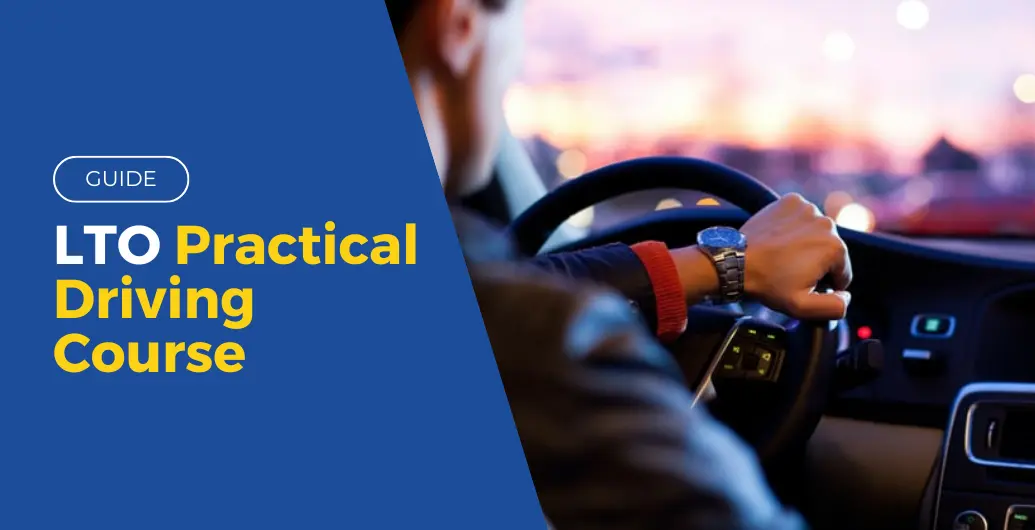Considering applying for a new driver’s license? Or perhaps you want to add a new restriction code to your existing one? Look no further, the Land Transportation Office has covered you through their PDC or Practical Driving Course.
The Practical Driving Course (PDC) is an eight-hour training course that provides hands-on driving instruction for aspiring drivers. Upon completion, participants receive a PDC certificate, which fulfills one of the requirements for a driver’s license application.
Table of Contents
During the 8-hour PDC training, you can expect to learn the following:
- Pre-driving checkup
- Checking of tires and batteries
- Adjusting mirrors, lights, and windshield
- Using a seatbelt/helmet
- Checking the hand and foot brake
- Disengaging the clutch when starting the engine
- Driving skills
- Steering
- Engine control
- Using brakes
- Speed control
- Turning left, right, and U-turn
- Backing and Parking
- Observance of traffic rules
- Right of way to other vehicles
- Stop lights/signals and others
- Right of way
Please note that the PDC certificate is not an additional requirement from the LTO. Many people argue that it is anti-poor, given that the course can cost between Php 1,400 and Php 8,000 at an LTO-accredited Driver Education Center (DEC). Fortunately, there are free alternatives.
You can obtain the certificate from any LTO-accredited driving school, authorized driving school instructors/administrators, and LTO Driver Education Centers (DECs) in LTO offices if cost is not a concern.
Also Read: GUIDE: LTO Theoretical Driving Course
Who Requires the LTO Practical Driving Course (PDC) Certificate?
Anyone can enroll in the LTO Practical Driving Course (PDC) and obtain a PDC certificate. However, this certificate is particularly beneficial for the following:
- Those upgrading their student permit to a non-professional driver’s license.
- Professional and non-professional driver’s license holders are seeking to apply for additional restriction codes (RC).
PDC Requirements
Regardless of whether individuals take the PDC from LTO Driver Education Centers (DECs) in LTO offices, LTO-accredited driving schools, or authorized driving school administrators/instructors, the requirements for taking the PDC remain the same. Thus, only the following individuals are permitted to take the PDC:
- Filipinos aged 17 and above but under 65
- Filipino drivers looking to add additional restriction codes to their licenses
- Foreign nationals holding a Philippine-issued driver’s license
- Foreign nationals in the Philippines, aged between 17 and 65, who want to obtain a Philippine driver’s license
To acquire a PDC certificate, you need to prepare the following:
- A valid driver’s license or student permit
- Your own motor vehicle (which must be accompanied by a duly licensed driver)
- A Vaccination Card
- A black or blue ballpen
- A confirmed LTO appointment slip
- Your own safety gear (elbow pad, knee pad, and helmet)
How to Acquire an LTO Practical Driving Course (PDC) Certificate?
To get a PDC certificate, you must follow the following steps:
- Check the schedule for the Practical Driving Course (PDC) at an LTO-accredited driving school, an LTO DEC, or any LTO office. This is especially important if you’re interested in receiving free PDCs.
- Choose your preferred schedule and PDC based on your driving needs, then reserve a slot.
- Enroll in your selected course and schedule.
- Attend the course during your chosen schedule and finish the driving exercises and the required driving hours.
- Pass the daily evaluation conducted by the driving instructors.
- After you complete your PDC, the system uploads your certificate of completion and biometric data directly to the LTO website.
Also Read: GUIDE: TESDA Automotive Course
Here are some crucial points to remember:
- Free PDC is available at selected LTO DECs, so regularly check for available schedules.
- Only new driver’s license applicants whose student-driver permits were issued from August 3 onwards are required to have PDC certificates.
- A valid student permit is required to take the PDC.
- Ensure you arrive on time to avoid losing your appointment.
- Either bring your own motor vehicle or set aside funds for rental if the fees don’t include the vehicle use charge.
- Some LTO DECs only cater to a limited number of applicants per day, so arrive on time to secure your slot.
- Applicants for Additional Restriction Codes (RC) must also secure a PDC certificate. The requirements for this certificate will vary depending on the RC you are applying for.
- Switch all communication devices to silent mode.
- Remember to bring your own ballpoint pen.
- PDC trainees will need to undergo a series of driving exercises. Therefore, students are required to bring the following:
- A valid driver’s license or student permit
- Their own motor vehicle (must be accompanied by a duly licensed driver).
11. Wear decent and appropriate attire.
12. Individuals under the influence of alcohol or drugs will not be allowed to take the course.
The PDC or Practical Driving Course is an invaluable resource for those wishing to apply for a new driver’s license or add new restriction codes to their existing one. The course, while comprehensive and demanding, equips participants with the necessary knowledge and skills to navigate the roads safely and responsibly.
While investing in LTO’s PDC involves a cost, it’s well worth it, given the extensive experience and knowledge it offers. Remember to look for free PDCs at selected LTO DECs and prepare well for the course to maximize the experience.
Final Thoughts
Overall, LTO’s practical driving course is an essential step to getting one’s driver’s license. It equips aspiring drivers with the necessary knowledge and skills to navigate the roads safely. Students who complete this would also receive a PDC certificate which would then complete their requirements for a driver’s license.
Also Read: LIST: Driving Schools Accredited by LTO



Leave a Reply